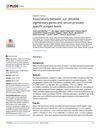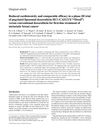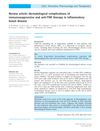Cutaneous Lesions in the Rat Following Administration of an Irreversible Inhibitor of erbB Receptors, Including the Epidermal Growth Factor Receptor
April 2008
in “
Toxicologic Pathology
”
TLDR CI-1033 causes skin lesions in rats, similar to humans, due to EGF receptor inhibition.
CI-1033 (canertinib), an irreversible inhibitor of the erbB family of receptors including the EGF receptor, was studied for chronic toxicity in Wistar rats, revealing cutaneous lesions similar to those observed in humans. The study involved 15 male and 15 female rats per group, administered doses of 2.5, 5, or 10 mg/kg for 27 weeks. Skin lesions, including papules, crusts, scales, and alopecia, were dose-dependent and more pronounced in females. Microscopic examination identified three patterns of skin changes, including epidermal hyperplasia and folliculitis, correlating with alopecia. Additional findings included hepatic cholestasis and epithelial atrophy at doses ≥2.5 mg/kg. The study concluded that CI-1033 induced cutaneous lesions consistent with EGF receptor inhibition, validating the rat as a model for studying this toxicity.






